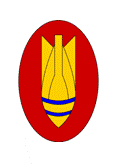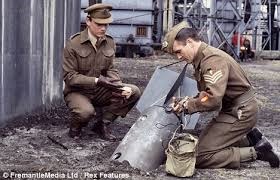

101 (City of London) Engineer Regiment
(Explosive Ordnance Disposal & Search)
Regimental Association
85 Years of Bomb Disposal - 1940-1945 WW2 
To address the technical information gap, a research committee was set up to support technical problems. This led to technical instructions on how and where to cut into bomb casings to steam out the explosives and methods to deal with fuzes (Render Safe Procedures (RSPs)). This also led to an increase in equipment designed to enable the operator to deal with the situation he was to face.
 The first German fuze types were relatively basic and could be dealt with by known RSPs. The Germans were constantly evolving their equipment to try and defeat the Bomb Disposal team. A notable type was the Y Fuze (called Type 50 and 50B by the Germans) which was deployed in early January 1943. This used an electric anti-disturbance fuze utilising three mercury switches to detonate the bomb if the fuze was disturbed or rotated. Fortunately, the RE have some incredibly talented men and Major John Pilkington Hudson CBE GM and bar VMH was responsible for developing a successful RSP just six days after an intact fuze was recovered. He developed a system to ‘deaden’ the batteries of this electrical fuze using liquid oxygen thus defeating the anti-handling capability and was able to safely disable a half ton UXB near the Albert Bridge in London for which he was the first to receive the George Medal in 1943. Major Hudson had a glorious career and was awarded the bar to his GM for successfully diffusing the first ‘doodlebug’ (V1 Rocket) that landed intact at Strawberry Hill Farm, Staplecross, Sussex in 1944. Upon inspection Major Hudson found a new type of unmarked fuze along with two known ones. It had to be removed at all costs and following a complex operation took nine days to inspect and remove safely. This operation saw the use of X-Ray to see inside the fuze, identify the design and develop a method to deliver an RSP.
The first German fuze types were relatively basic and could be dealt with by known RSPs. The Germans were constantly evolving their equipment to try and defeat the Bomb Disposal team. A notable type was the Y Fuze (called Type 50 and 50B by the Germans) which was deployed in early January 1943. This used an electric anti-disturbance fuze utilising three mercury switches to detonate the bomb if the fuze was disturbed or rotated. Fortunately, the RE have some incredibly talented men and Major John Pilkington Hudson CBE GM and bar VMH was responsible for developing a successful RSP just six days after an intact fuze was recovered. He developed a system to ‘deaden’ the batteries of this electrical fuze using liquid oxygen thus defeating the anti-handling capability and was able to safely disable a half ton UXB near the Albert Bridge in London for which he was the first to receive the George Medal in 1943. Major Hudson had a glorious career and was awarded the bar to his GM for successfully diffusing the first ‘doodlebug’ (V1 Rocket) that landed intact at Strawberry Hill Farm, Staplecross, Sussex in 1944. Upon inspection Major Hudson found a new type of unmarked fuze along with two known ones. It had to be removed at all costs and following a complex operation took nine days to inspect and remove safely. This operation saw the use of X-Ray to see inside the fuze, identify the design and develop a method to deliver an RSP.Unfortunately during this time many Royal Engineers were lost as the Germans constantly updated the design of their systems to counter our intelligence and RSPs.

